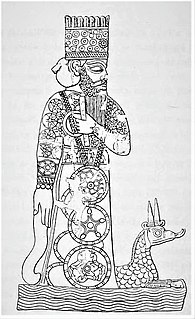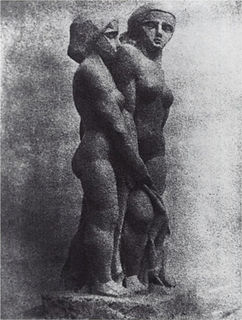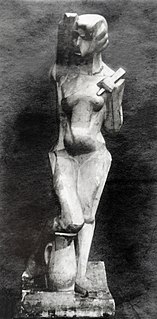 W
WAmerica is a sculpture created in 2016 by the Italian artist Maurizio Cattelan. An example of satirical participatory art, it is a fully functioning toilet made of 18-karat solid gold. It was stolen in 2019 from Blenheim Palace, where it was exhibited on loan from the permanent collection of the Solomon R. Guggenheim Museum.
 W
WThe Aphrodite of Knidos was an Ancient Greek sculpture of the goddess Aphrodite created by Praxiteles of Athens around the 4th century BC. It is one of the first life-sized representations of the nude female form in Greek history, displaying an alternative idea to male heroic nudity. Praxiteles' Aphrodite is shown nude, reaching for a bath towel while covering her pubis, which, in turn leaves her breasts exposed. Up until this point, Greek sculpture had been dominated by male nude figures. The original Greek sculpture is no longer in existence; however, many Roman copies survive of this influential work of art. Variants of the Venus Pudica are the Venus de' Medici and the Capitoline Venus.
 W
WAthena Parthenos is a lost massive chryselephantine sculpture of the Greek goddess Athena, made by Phidias and his assistants and housed in the Parthenon in Athens; this statue was designed as its focal point. Parthenos was an epithet of Athena. There have been many replicas and works inspired by the statue, in both ancient and modern times. Athena was the Greek goddess of wisdom, warfare, and handicrafts.
 W
WBicycle Wheel is a readymade from Marcel Duchamp consisting of a bicycle fork with front wheel mounted upside-down on a wooden stool.
 W
WThe Colossus of Rhodes was a statue of the Greek sun-god Helios, erected in the city of Rhodes, on the Greek island of the same name, by Chares of Lindos in 280 BC. One of the Seven Wonders of the Ancient World, it was constructed to celebrate the successful defence of Rhodes city against an attack by Demetrius Poliorcetes, who had besieged it for a year with a large army and navy. According to most contemporary descriptions, the Colossus stood approximately 70 cubits, or 33 metres high – approximately the height of the modern Statue of Liberty from feet to crown – making it the tallest statue in the ancient world. It collapsed during the earthquake of 226 BC, although parts of it were preserved. In accordance with a certain oracle, the Rhodians did not build it again. John Malalas wrote that Hadrian in his reign re-erected the Colossus, but he was mistaken. According to Suda, the Rhodians were called Colossaeans (Κολοσσαεῖς), because they erected the statue on the island.
 W
WFilipina Comfort Women was a statue publicly displayed along Baywalk, Roxas Boulevard in Manila. Unveiled on December 8, 2017, and installed through the National Historical Commission of the Philippines (NHCP) and other donors and foundations, it was dedicated to the Filipino "comfort women", who worked in military brothels in World War II including those who were coerced into doing so.
 W
WFountain is a readymade sculpture by Marcel Duchamp in 1917, consisting of a porcelain urinal signed "R. Mutt". In April 1917, an ordinary piece of plumbing chosen by Duchamp was submitted for an exhibition of the Society of Independent Artists, the inaugural exhibition by the Society to be staged at The Grand Central Palace in New York. When explaining the purpose of his Readymade sculpture, Duchamp stated they are "everyday objects raised to the dignity of a work of art by the artist's act of choice." In Duchamp's presentation, the urinal's orientation was altered from its usual positioning. Fountain was not rejected by the committee, since Society rules stated that all works would be accepted from artists who paid the fee, but the work was never placed in the show area. Following that removal, Fountain was photographed at Alfred Stieglitz's studio, and the photo published in the Dada journal The Blind Man. The original has been lost.
 W
WHead of a Faun is a lost sculpture by Italian Renaissance master Michelangelo, dating from c. 1489. His first known work of sculpture in marble, it was sculpted when he was 15 or 16 as a copy of an antique work with some minor alterations. According to Giorgio Vasari's biography of the artist, it was the creation of this work that secured the young Michelangelo the patronage of Lorenzo de' Medici.
 W
WHouse was a temporary public sculpture by British artist Rachel Whiteread, on Grove Road, Mile End, in the London Borough of Tower Hamlets. It was completed on 25 October 1993 and demolished eleven weeks later on 11 January 1994. The work won Whiteread the Turner Prize for best young British artist and the K Foundation art award for the worst British artist in November 1993.
 W
WThe Jewel of Vicenza was a silver model of the city of Vicenza made as an ex-voto in the 16th century and attributed to the architect Andrea Palladio. The Jewel was stolen by the Napoleonic army during the Italian Campaign in the French Revolutionary Wars and subsequently destroyed. A copy was created between 2012 and 2013.
 W
WThe Lemnian Athena, or Athena Lemnia, was a classical Greek statue of the goddess Athena. According to geographer Pausanias (1.28.2), the original bronze cast was created by the sculptor Phidias circa 450–440 BCE, for Athenians living on the island of Lemnos to dedicate on the Acropolis of Athens.
 W
WThe statue of Pericles with the Corinthian Helmet is a lost, life-sized statue of the Athenian statesman and general Pericles. Today, only some of the base survives. Four Roman Imperial-era marble busts modelled after the head of the statue are known.
 W
WThe Regisole was a bronze classical or Late Antique equestrian monument, highly influential during the Italian Renaissance but destroyed in 1796. It was originally erected at Ravenna, in what is now Italy, but was moved to Pavia in the Middle Ages, where it stood on a column before the cathedral, as an emblem of communal pride and Pavia's deep connection with imperial Rome.
 W
WSpindle was a sculpture created in 1989 by artist Dustin Shuler (1948–2010). It consisted of a 50-foot spike with eight cars impaled on it.
 W
WThe Statue of Marduk, also known as the Statue of Bêl, was the physical representation of the god Marduk, the patron deity of the ancient city of Babylon, traditionally housed in the city's main temple, the Esagila. There were seven statues of Marduk in Babylon, but 'the' Statue of Marduk generally refers to the god's main statue, placed prominently in the Esagila and used in the city's rituals. This statue was nicknamed the Asullḫi and was made of a type of wood called mēsu and covered with gold and silver.
 W
WThe Statue of Sobekneferu was a sculpture of the ancient Egyptian queen Sobekneferu, who reigned during the 12th Dynasty.
 W
WThe Theodore Roosevelt Memorial is a lost monument and sculpture commemorating the 26th president of the United States, Theodore Roosevelt, as well as veterans of the Spanish–American War. It was originally installed in Portland's Battleship Oregon Park. Designed by American artist Oliver L. Barrett, the 18-foot (5.5 m) memorial was erected in 1939, but disappeared in 1942 after being relocated temporarily during the construction of Harbor Drive. It featured a geometric tufa statue depicting a man not resembling Roosevelt, as well as a smaller realistic sculpture of him. The monument initially received a generally unfavorable reception, but was considered one of Barrett's best-known artworks.
 W
WTilted Arc was a controversial public art installation by Richard Serra, displayed in Foley Federal Plaza in Manhattan from 1981 to 1989. The art work consisted of a 120-foot-long, 12-foot-high solid, unfinished plate of rust-covered COR-TEN steel. Advocates characterized it as an important work by a well-known artist that transformed the space and advanced the concept of sculpture, whereas critics focused on its perceived ugliness and saw it as ruining the site. Following an acrimonious public debate, the sculpture was removed in 1989 as the result of a federal lawsuit and has never been publicly displayed since, in accordance with the artist's wishes.
 W
W W
W W
W W
W W
W W
W W
W W
W W
W